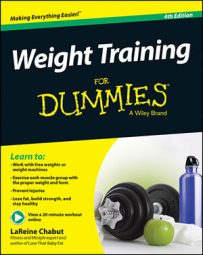Countless ways exist to put the various elements of weight machines together. Here’s a look at six different types of weight machines you could come across when weight training.
Weight-stack machines
Traditional weight-stack machines have a stack of rectangular weight plates, each weighing 5 to 20 pounds. Each plate has a hole in it; to lift 50 pounds, you stick a metal pin in the hole of the weight plate marked 50. When you perform the exercise — by pushing or pulling on a set of handles or levers — the machine picks up the plate marked 50, plus all the plates above it.
Weight-stack machines save time because changing the amount of weight you’re lifting is easier.
Plate-loaded machines
Plate-loaded machines fuse traditional machines and free weights. They have a large frame and protect you from dropping any weight on the floor, but they aren’t attached to a stack of weight plates; instead, you place any number of round weight plates onto large pegs.
Some of these plate-loaded machines are gimmicky. They offer no benefits over traditional machines — unless you happen to enjoy carrying weight plates around the gym. However, some of the plate-loaded machines let you work each side of your body separately.
Other varieties have “free-floating” levers. Instead of forcing you to move through a fixed pathway, the machines let you move any way you want. These machines mimic the feel of free weights (for the most part) while retaining most of the safety benefits of a weight machine.
Hydraulic and air-pressure machines
This machine category doesn’t have a weight stack either. Hydraulic and air-pressure machines have a series of pistons that create resistance by pumping oil, gas, or fluid.
These machines are fine — some are very well designed — but some exercisers don’t feel motivated when they use them because a weight stack isn’t moving up and down or steel isn’t clanging. (Some people have quirks about working out.) All you hear is a sound that’s similar to a can of hair spray in action. Gyms that offer 30-minute circuit programs often use these machines.
Electronic machines
These high-tech contraptions may be the future of weight machines. Some varieties have computers built right in. You swipe an ID card into the machine, which automatically sets the resistance based on your last workout. As you do your set, the machine sends you technique tips. Other electronic systems attach to regular weight-training machines. You punch in a code and the machine retrieves your personal information.
The advantage of electronic machines is the storing of your information. This feature is great for beginners, who may be too overwhelmed to remember how much they lifted last time. These systems also run a variety of extensive reports so you can analyze your training in depth. For instance, you can compare your progress on the leg press to your progress on the leg extension. Serious athletes may find this information useful.
However, what’s new isn’t always better. Electronic machines slow down the pace of the gym and remove some of the human element involved in working out. Instead of interacting with the staff and other members, you interact with a machine.
Also, if the system goes down, the repair process generally takes longer than it does with your basic weight-stack machine. And, the electronic systems aren’t connected with free weights, so computer-dependent lifters may be discouraged from experimenting with dumbbells and barbells.
Smith machines
The Smith machine — named for an influential 1970s fitness figure named Randy Smith — features a regular free-weight bar trapped inside a track so that the bar must travel straight up and down. The Smith machine increases the safety of exercises such as bench presses, overhead lifts, and squats because you don’t have to worry about the bar wobbling or slipping from your grip.
At the same time, the machine retains the feel of free weights. Many Smith machines possess another safety feature: self-spotting pins jutting out from the frame. These pins prevent the bar from being lowered below a certain point, so there’s no chance you’ll get crushed under the bar if the weight is too heavy.
Smith machines use a traditional 45-pound bar, but in some cases, the bar balances on springs to negate most or all of its weight. The purpose is to add smoothness to the movement. Many lifters don’t like this feature because it takes away from the macho spirit of weight lifting. Also, the movement is a bit too smooth, removing all the coordination and extra muscle usage associated with lifting free weights.
Power cages
A power cage is a large steel frame with a series of stanchions affixed to the sides. You stand in the center of the cage and place your bar on the stanchions that are at the right height for your lift. A power cage doesn’t offer as much safety as a Smith machine because after you lift the bar from the stanchions, you’re on your own.
Still, the cage does offer an extra measure of protection during heavy lifts or lifts that require a lot of balance. And if your muscles give out, the stanchions catch the weight before it crashes to the floor.

